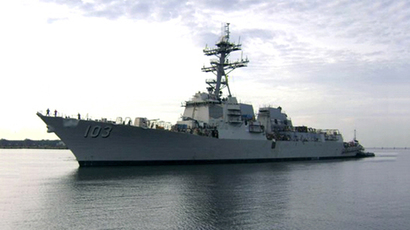NATO’s merry-go-round electronic surveillance in the Black Sea

A French stealth frigate is reportedly conducting electronic surveillance of Russian coastal infrastructure in the Black Sea. The deepening political turmoil in Ukraine has prompted NATO to maintain warships in the region around the clock.
French stealth frigate Surcouf, which passed Turkey’s Bosphorus strait and entered the Black Sea on May 28, is conducting a SIGINT operation in immediate proximity to the Russia’s Black Sea Fleet installations in the Crimea peninsula, Itar-Tass reported, citing an unnamed source in the Russian diplomatic corps.
The frigate is maneuvering in the northern Black Sea, occasionally coming within 50 to 60 kilometers of the Russian shoreline, though not entering Russia’s territorial waters.
The Surcouf is believed to be busy eavesdropping “communications of military installations stationed along the coastline and collecting electronic intelligence on strategically important administrative infrastructure objects of the Crimea peninsula,” the source said.
The Surcouf replaced another French intelligence ship, Dupuy de Lome, which had been present in the Black Sea from May 14. Dupuy de Lome, a vessel designed for radar monitoring and capable of intercepting communications, including phone calls and e-mails, had previously been deployed to the Black Sea from April 11 to April 30.
The latest information suggests there are two NATO vessels deployed to the Black Sea now, the Surcouf and the US Navy Ticonderoga-class guided-missile cruiser USS Vella Gulf (CG 72), which entered the Black Sea on May 23. The USS Vella Gulf is reportedly moored in the port of Constanta, Romania.
Another NATO reconnaissance ship, Italy’s Elettra, is preparing to enter the Black Sea on June 15 and head close to Russian shores, RIA Novosti news agency reported Tuesday. The ship, with a deadweight of over 2,000 tons, has a crew of 100 and is equipped with over 30 systems of hydro-acoustic and radio-electronic reconnaissance, among them a submergence autonomous vehicle capable of making 1-kilometer-deep dives.
Following the meeting of the NATO member states’ defense ministers in Brussels on Tuesday, Secretary-General Anders Fogh Rasmussen told journalists that the ministers “agreed to go on with strengthening of the NATO collective defense by enhancing air and sea patrols… from the Baltic to the Black Sea and the Mediterranean.”
Maritime turnabout
Over the last four months, there have been a number of NATO warships paying visits to the Black Sea.
The currently deployed in the area USS Vella Gulf replaced the USS Taylor, a frigate that was deployed to the region from April 24 through May 12, and its shift was in turn preceded by the presence of the destroyer USS Donald Cook, deployed to the Black Sea in early April.

All the American battleships took part in various training maneuvers with US allies in the region: Bulgaria, Georgia, Romania and Turkey.
The reason why NATO has to constantly replace warships in the Black Sea is the Montreux Convention, a US-authorized treaty from 1936, which bars outside countries from keeping warships in the Black Sea for more than 21 days.
According to the convention, the maximum deadweight of a non-regional warship in the Black Sea should not exceed 45,000 tons, which also bans passage of US air carriers into the Black Sea.
The caravan of NATO ships in the region began with escalation of the political crisis in Ukraine, particularly after Crimeans voted to leave Ukraine and join Russia in a referendum.
In early March, Washington sent USS Truxtun Arleigh Burke-class destroyer to the Black Sea to keep a closer eye on the Russian forces deployed to the Crimea peninsula.

At the time there was another American battleship in the region, the guided missile frigate USS Taylor, which had been assigned to the Black Sea for the Sochi Winter Olympics.
The USS Taylor actually became a rare example of a ship that violated the Montreux Convention by exceeding the limited time of deployment to the Black Sea by 11 days, as the crew claimed the vessel ran aground on February 12 and had to undergo maintenance in the Turkish port of Samsun.

Russian maritime experts have shared their concerns about the presence of US battleships with Aegis ABM systems aboard so close to the Russian shore.
Russian MP Mikhail Nenashev told RIA Novosti in April that the presence of such ships in the Black Sea “is only needed to show that they have not abandoned their intention to deploy sea-based ABM defense systems.”
The constant presence of NATO warships equipped with the Aegis Ballistic Missile Defense System and SM-3 interceptor missiles allows them to function as part of the US missile shield program in Europe. And it comes as part of a wider buildup of NATO forces close to Russian borders against the backdrop of the Ukraine crisis.
The deployment of US and NATO warplanes, ships and troops close to Russian borders has prompted Moscow’s concerns.
“Our concern is caused by an increase of US air force and the American military personnel in the Baltic, Poland, and also the Alliance's ships in the Black Sea,” the Defense Ministry said in a statement, quoting Russia’s Chief of General Staff, General Valery Gerasimov.
NATO war games in Eastern Europe are also “not helping” to normalize the situation, Russia's defense minister Sergey Shoigu said earlier.
NATO military buildup in the Black Sea could explain an incident with the Russian Su-24 fighter jet and the USS Donald Cook destroyer that took place on April 12 close to the Crimea peninsula, when for 90 minutes an unarmed Russian Su-24 simulated low-altitude attacks on the US destroyer, flying by the battleship at a distance of less than 1 kilometer, at altitudes of 150 meters, and making overall 12 strike runs.
After the incident, the USS Donald Cook destroyer retreated to Romanian territorial waters.















